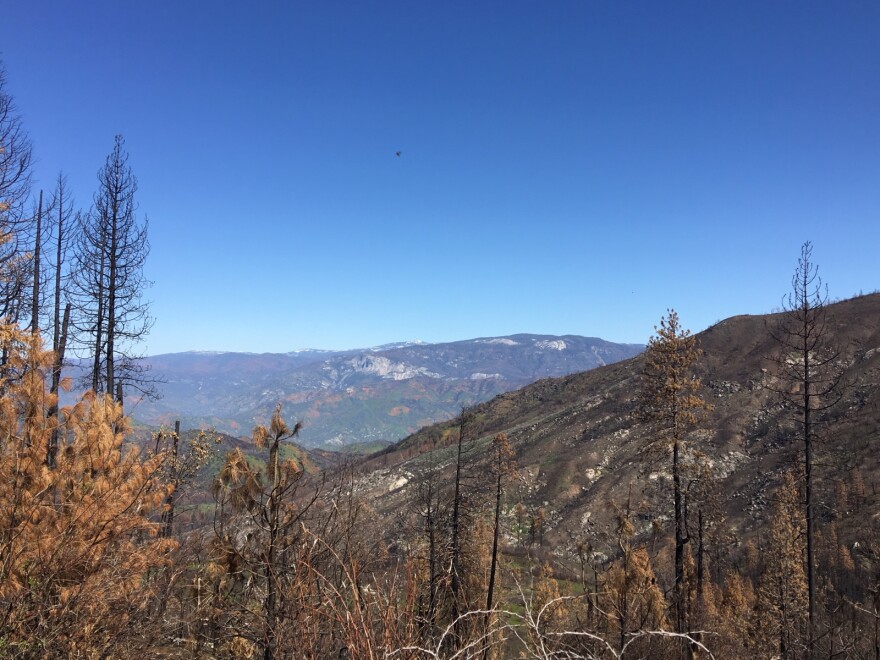UPDATE: Since this story was produced the Pacific fisher population in the Southern Sierra Nevada has been listed as threatened under the California Endangered Species Act. The Pacific Fisher was not listed as threatened under the Federal Endangered Species Act.
There’s a furry little animal that lives in the mountains along the West Coast that soon could get an added step of protection by being listed as threatened both in California and nationally. And as FM89’s Ezra David Romero reports they face a number of threats including wildfire.
Christa Hollon and her class of kindergartners from Horace Mann Elementary School in Bakersfield are on a tour of a zoo called the California Living Museum full of animals native to the Golden State.

They just saw coyotes, a pair of bald eagles and a black bear. Now they’re looking at a mammal that looks like a chubby weasel.
“He’s called a?” Hollon says.“ Taz, Taz, Taz that’s his name.”
Taz and his girlfriend Lola are Pacific fishers.
“So they’re in the same family that you would find the wolverines, pine martins, things like skunks,” says Don Richardson who curates the animals at the zoo in Kern County.
The cat-sized mammal has a long bushy tail and a cute foxlike nose. Even though they’re relatively harmless to people, fishers are ferocious hunters. They even like the taste of porcupine. Taz was also very curious about my microphone.
"What they'll do is continue attack the face until it is weakened and then they can flip the porcupine over and go for the soft underbelly of the porcupine."
The pair of fishers was born in captivity, but their wild relatives are in danger. At one time there were thousands of fishers in the wild, but that number has dwindled and in the Southern Sierra Nevada there’s an isolated population with as few as 300 living in the area between the Merced and Kern Rivers. The fisher population first began to decrease around 100 years ago.
“You can see the heavy coat,” says Richardson. “That’s part of the reason that the numbers are getting lower and lower. They were heavily impacted in the fur trade.”

Groups like the Center for Biological Diversity have collected signatures for decades in order to get both state and federal governments to list the fisher as an endangered species.
“As of right now, you know 24 years later, the fisher is still waiting for the protection that it desperately needs,” says Tierra Curry is a senior scientist with the group.
Curry’s organization would like state and federal fish and wildlife agencies to protect the fisher from any further decrease in population from logging, climate change or new development. That includes the threat of poisoning.
“The new emergent threat is rodenticides that are used in marijuana cultivation operations and so the fishers are getting poisoned on these marijuana farms,” Curry says.
Fishers in the Southern Sierra Nevada have to deal with another issue, the effects of fire. Sequoia National Forest Wildlife Biologist Jeff Cordes says last year’s Rough Fire burned over 25,000 acres of prime fisher habitat in the area of forest he helps maintain. We’re looking over the Kings River from about 8,500 feet at McKenzie Ridge.
CORDES: “The Rough Fire got right along this ridge. You can see what areas burnt and what areas haven’t.”
ROMERO: “Yeah, just north of us everything is dead.”
Cordes says burned areas like this are a problem for the fisher.
“If you’re talking about a male fisher it may use an area of 5,000 acres,” says Cordes. “A fire that burns this hot breaks that up into smaller pieces. If we lose substantial pieces of that there may not be enough habitat for them to survive.”
He also says warming temperatures and drought have altered fisher habitat, especially in the three to four thousand foot elevation where bark beetle has ravaged the forest. He says this sudden change of habitat will eventually push fishers to live at higher and higher elevations.

“Habitat change is probably more important and if you remove thick canopy, fishers aren’t going to have what they need to survive,” Cordes says.
To help save the fisher the California Fish and Game Commission recently voted to list the species as threatened in the Southern Sierra Nevada and should go into effect in couple weeks. The California Department of Fish and Wildlife says the national listing under the federal endangered species act is still in the works and could be added later this month.
“Do you guys know what group of animals the fisher belongs to?” says Richardson. “It belongs to a group called the mustelids.”
Back at the California Living Museum Don Richardson’s mission is to educate the public about how vital the fisher is to California.
“Everything in nature relies on each other,” Richardson says. “It’s like a big circle. Losing the fisher off of that circle means that more animals will be impacted. It’s important we get them on the endangered species list.”
Richardson says he hopes the federal listing comes quickly so the fisher all the across the west will have a chance of survival in the wild.



